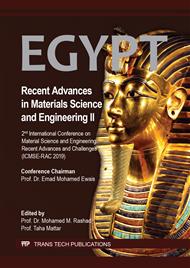[1]
J.G. Machado, F.A. Brehm, C.A. Moraes, C.A. Santos, A.C. Vilela, J.B. Cunha, Chemical, physical, structural and morphological characterization of the electric arc furnace dust, J. Hazard. Mater. 136 (3) (2006) 953-960.
DOI: 10.1016/j.jhazmat.2006.01.044
Google Scholar
[2]
T. Mansfeldt, R. Dohrmann, Chemical and mineralogical characterization of blast furnace sludge from an abandoned landfill, Environ. Sci. Technol. 38 (22) (2004) 5977-5984.
DOI: 10.1021/es040002+
Google Scholar
[3]
J. Szekely, A Research Program for the Minimization and Effective Utilization of Steel Plant Wastes, Iron and Steelmaker 22 (1) (1995) 25-29.
Google Scholar
[4]
M.V. Cantarino, C. Filho, M.B. Mansur, Selective removal of zinc from basic oxygen furnace sludges, Hydrometallurgy 111-112 (2012) 124-128.
DOI: 10.1016/j.hydromet.2011.11.004
Google Scholar
[5]
P. Van Herck, C. Vandecasteele, R. Swennen, R. Mortier, Zinc and lead removal from blast furnace sludge with a hydrometallurgical process, Environ. Sci. Technol. 34 (17) (2000) 3802-3808.
DOI: 10.1021/es991033l
Google Scholar
[6]
Z.H. Trung, F. Kukurugya, Z. Takacova, D. Orac, M. Laubertova, A. Miskufova, T. Havlik, Acidic leaching both of zinc and iron from basic oxygen furnace sludge, J. Hazard. Mater. 192 (3) (2011) 1100-1107.
DOI: 10.1016/j.jhazmat.2011.06.016
Google Scholar
[7]
Environmental Protection Agency, 2002, European Waste Catalogue and Hazardous Waste List.
Google Scholar
[8]
C. Wang, R. Jennes, O. Mattila, T. Paananen, J. Lilja, M. Larsson, Investigation of applying OxyCup® process for an integrated steel plant from a Nordic country, Düsseldorf, 15-19 June (2015).
Google Scholar
[9]
M. Omran, T. Fabritius, Improved removal of zinc from blast furnace sludge by particle size separation and microwave heating, Miner. Eng. 127 (2018) 265-276.
DOI: 10.1016/j.mineng.2018.08.002
Google Scholar
[10]
M. Omran, T. Fabritius, T. Paananen, Effect of blast furnace sludge (BFS) characteristics on suitable recycling process determining, JMMCE 5 (2017) 185-197.
DOI: 10.4236/jmmce.2017.54016
Google Scholar
[11]
R. Kretzschmar, T. Mansfeldt, P.N. Mandaliev, K. Barmettler, M.A. Marcus, A. Voegelin, Speciation of Zn in Blast Furnace Sludge from Former Sedimentation Ponds Using Synchrotron X-ray Diffraction, Fluorescence, and Absorption Spectroscopy, Environ. Sci. Technol. 46 (2012)12381-12390.
DOI: 10.1021/es302981v
Google Scholar
[12]
J. Vereš, M. Lovás, Š. Jakabský, V. Šepelák, S. Hredzák, Characterization of blast furnace sludge and removal of zinc by microwave assisted extraction, Hydrometallurgy 129-130 (2012) 67-73.
DOI: 10.1016/j.hydromet.2012.09.008
Google Scholar
[13]
K. Drobíková, D. Plachá, O. Motyka, R. Gabor, K.M. Kutláková, S. Vallová, J. Seidlerová, Recycling of blast furnace sludge by briquetting with starch binder: Waste gas from thermal treatment utilizable as a fuel, Waste Manag. 48 (2016) 471-477.
DOI: 10.1016/j.wasman.2015.11.047
Google Scholar
[14]
R. Robinson, Studies in low temperature self-reduction of by-products from integrated iron and steelmaking, DIVA, (2008).
Google Scholar
[15]
B. Das, S. Prakash, P.S.R. Reddy, V.N. Misra, An overview of utilization of slag and sludge from steel industries, Res. Conserv. Recycling 50 (1) (2007) 40-57.
DOI: 10.1016/j.resconrec.2006.05.008
Google Scholar
[16]
A. Persson, H. Ahmed, Energy efficient recycling of in-plant fines in rotary Hearth Furnace, 2014, Sweden.
Google Scholar
[17]
A. Andersson, H. Ahmed, J. Rosenkranz, C. Samuelsson, B. Björkman, Characterization and Upgrading of a Low Zinc-Containing and Fine Blast Furnace Sludge - A Multi-Objective Analysis, ISIJ Int. 57 (2017) 262-271.
DOI: 10.2355/isijinternational.isijint-2016-512
Google Scholar
[18]
S. Kelebek, S. Yörük, B. Davis, Characterization of basic oxygen furnace dust and zinc removal by acid leaching, Miner. Eng. 17 (2004) 285-291.
DOI: 10.1016/j.mineng.2003.10.030
Google Scholar
[19]
J. Vereš, Š. Jakabský, V. Šepelák, Chemical, physical, morphological and structural characterization of blast furnace sludge, Diffusion Fundamental 12 (2010) 88-91.
Google Scholar
[20]
A.J.B. Dutra, P.R.P. Paiva, L.M. Tavares, Alkaline leaching of zinc from electric arc furnace steel dust, Miner. Eng. 19 (2006)478-485.
DOI: 10.1016/j.mineng.2005.08.013
Google Scholar
[21]
R.K. Agrawal, P.K. Pandey, Productive recycling of basic oxygen furnace sludge in integrated steel plant, J. Sci. Ind. Res. 64 (2005) 702-706.
Google Scholar
[22]
A.K.P. Singh, M.T. Raju, U. Jha, Recycling of Basic Oxygen Furnace (BOF) sludge in iron and steel works, Int. J. Environ. Tech. Manag. 14 (2011)19-32.
DOI: 10.1504/ijetm.2011.039255
Google Scholar
[23]
D.E. Esezobor, S.A. Balogun, Zinc accumulation during recycling of iron oxides wastes in the blast furnaces, Ironmak. Steelmak. 33 (2006) 419-425.
DOI: 10.1179/174328106x114020
Google Scholar
[24]
S. Cho, J. Lee, Metal Recovery from Stainless Steel Mill Scale by Microwave Heating, Met. Mater. Inter. 14 (2008) 193-196.
DOI: 10.3365/met.mat.2008.04.193
Google Scholar
[25]
M. Omran, T. Fabritius, Treatment of blast furnace sludge (BFS) using a microwave heating technique, Ironmak. Steelmak. 43 (2016)1-11.
DOI: 10.1080/03019233.2016.1224032
Google Scholar
[26]
K. Nishioka, T. Maeda, M. Shimizu, Dezincing Behavior from Iron and Steelmaking Dusts by Microwave Heating, ISIJ Int. 42 (2002) S19-S22.
DOI: 10.2355/isijinternational.42.suppl_s19
Google Scholar
[27]
K. Morita, M. Guo, N. Oka, N. Sano, Resurrection of the Iron and Phosphorus Resource in Steel-making Slag, J Mater. Cycles Waste 4 (2002) 93-101.
Google Scholar


